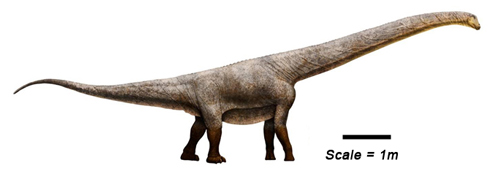The Rediscovering of Australia’s First Cretaceous Dinosaur
Original Quarry where Fossils of Austrosaurus Found Re-Located – Australia’s First Cretaceous Dinosaur
More fossils of the very first Cretaceous dinosaur to be described from Australia have been excavated over the winter months and scientists could be on the verge of solving a mystery surrounding whether the titanosaur named Austrosaurus mckillopi deserves to be a valid genus or not.
The winter months (Southern Hemisphere), are the best months to conduct field work in Queensland (Australia), although still hot, the daytime temperatures are nowhere near as high as they are in the summer and the months of June through to the early part of September are regarded as the season of field work when volunteers join palaeontologists on organised digs, excavating the rich Mesozoic fossil heritage of this Australian State. Austrosaurus means (southern lizard), scientists have estimated that this dinosaur may have reached lengths in excess of fifteen metres.
For replicas of prehistoric animals and other figures: CollectA Prehistoric Life Models.
Australia’s First Cretaceous Dinosaur
Back in 1932, a farm worker found some fragments of bone that turned out to be vertebrae from a huge titanosaur. The fossils were very unusual as the location of the fossil find – Clutha Station close to the settlement of Richmond had provided scientists with some excellent examples of marine reptiles. The sediments deposited in this area represented a marine environment, however, the carcase of a large, herbivorous dinosaur had been washed out to sea and the fossils had been exposed on the surface due to erosion. Sadly, the fossil location was lost and although a dinosaur was named based on the fragmentary remains (Austrosaurus), no further material could be recovered.
That was until last year, when the mayor of Richmond John Wharton set out to search the Clutha Station area in a bid to re-discover the fossil site. Searching by truck did not prove successful, but when a helicopter was hired, two wooden posts in the ground were soon spotted from the air and on further inspection this proved to be the site of the 1932 fossil discovery. A preliminary investigation led to a full-scale excavation taking place during this year’s field work season.
Finding Fossil Bones
A number of pinkish-white bones were excavated, including some very well preserved rib bones, the largest of which measure 1.6 metres in length. These bones are very likely part of the same skeleton as the vertebrae discovered in 1932. The bones are currently on display at the Kronosaurus Korner museum in Richmond. Further preparation and cleaning will be undertaken and then an analysis carried out comparing this, now more complete skeleton to the fossilised remains of Wintonotitan wattsi, another Australian titanosaur, whose fossils have been recovered from rocks of a similar age, but the majority of these fossil finds have taken place to the south of the town of Richmond (near to Winton).
Dr Steve Poropat, a scientist from the Australian Age of Dinosaurs Museum (based at Winton), the town after which Wintonotitan was named stated:
“Rediscovering a historical dinosaur dig site was almost more exciting than finding a brand new one. Once we knew where the site was, we knew we had the chance to find more of the same Austrosaurus specimen and all that was separating us from it was a metre or so of black soil.”
Trying to Find the Original Dig Site
Attempts had been made in the 1970s and 1980s to relocate the original Austrosaurus dig site, but they had all been unsuccessful. Thanks to the dedicated folk of Richmond and the surrounding area, Australian scientists have the opportunity to learn more about the first Cretaceous dinosaur to be described in Australia and to find out whether Wintonotitan and Austrosaurus deserve to be separate genera.
An Illustration of Austrosaurus (Austrosaurus mckillopi)
In January, Everything Dinosaur predicted that this year would be an important one for Australian dinosaur discoveries. There have been a number of fantastic fossil finds and it is great to hear the 1932 fossil site has been rediscovered.
To read more about Everything Dinosaur’s predictions for 2015: Palaeontology and Fossil Predictions for 2015.
To read more about other titanosaur discoveries from Australia including Wintonotitan: A Trio of Aussie Dinosaurs.


